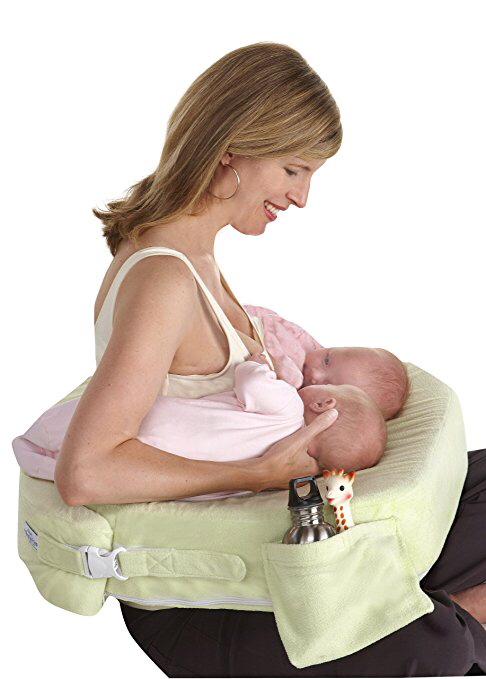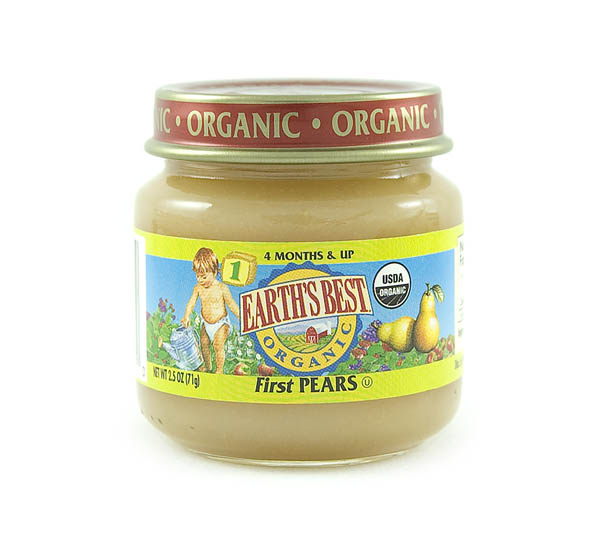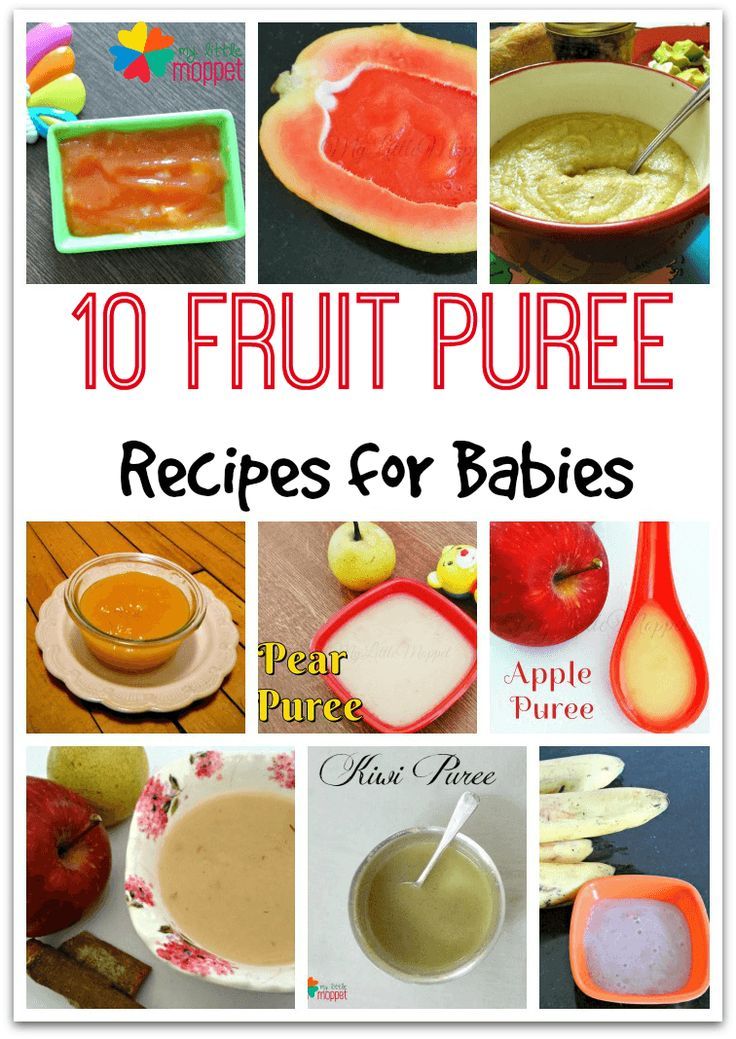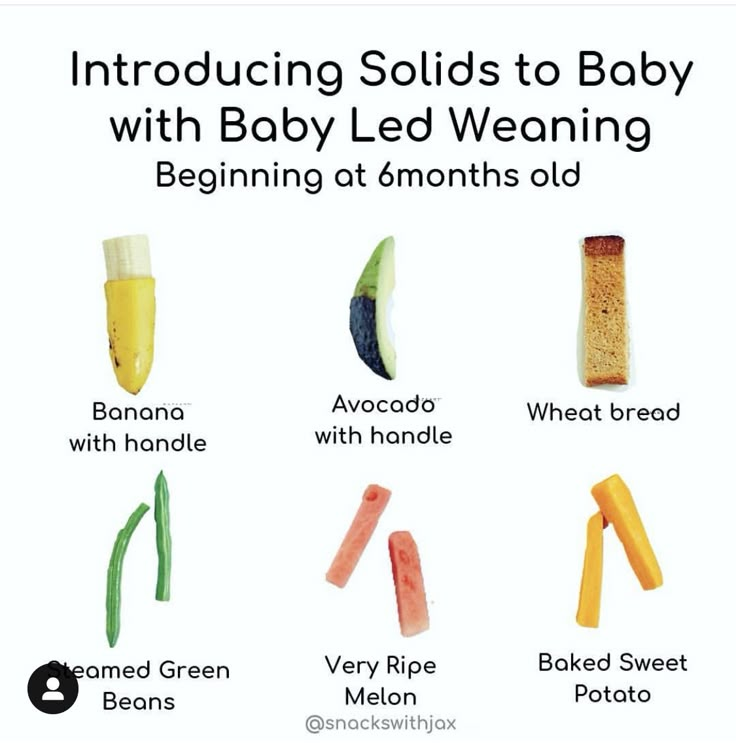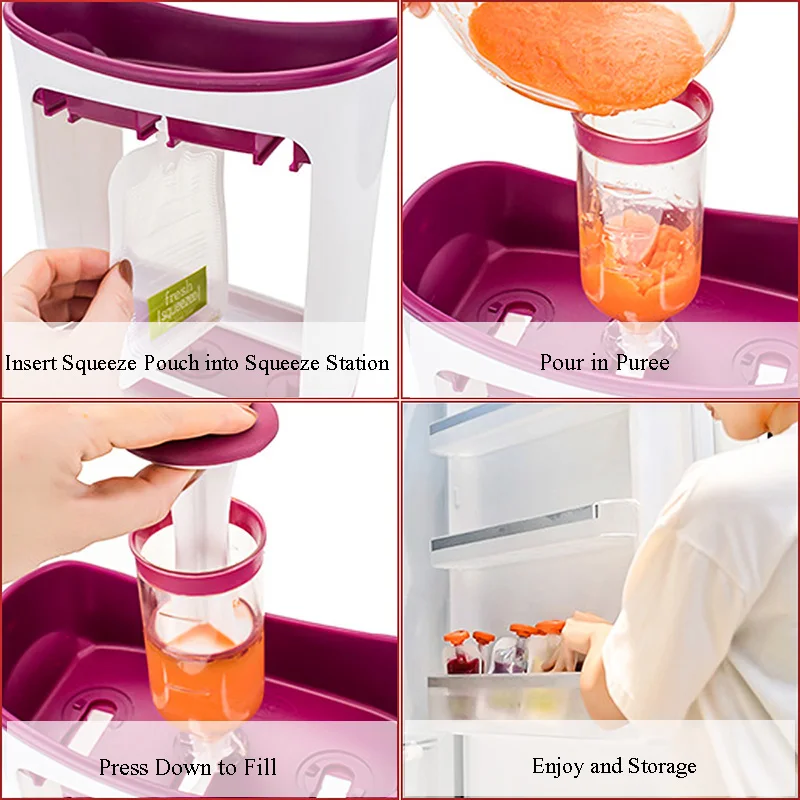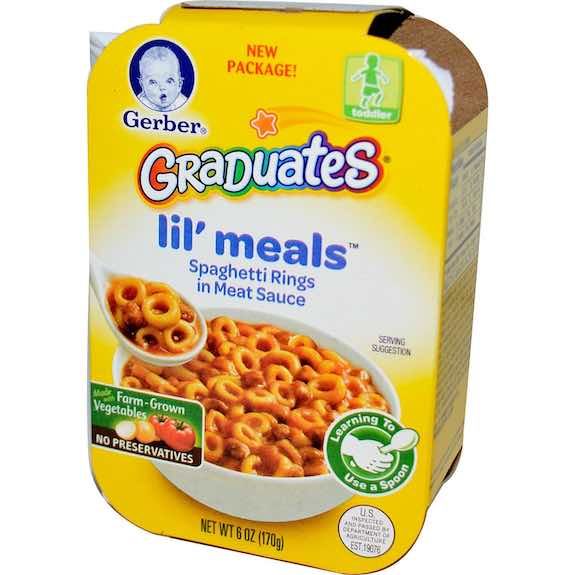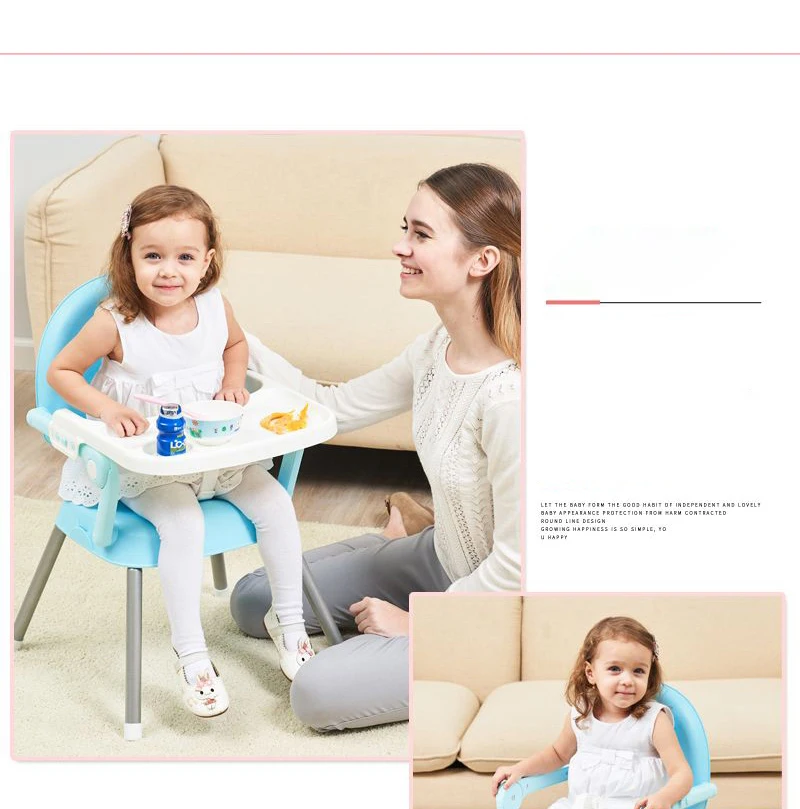Solid food stages for babies
The 3 baby food stages: What foods and when
Making the leap from breast milk or formula to solids and then eventually to table food is an exciting time. But it’s also a little confusing because there isn’t a one-size-fits-all rule when it comes to baby food stages. While one child may happily take to pureed carrots at 6 months, another may purse their lips at anything but a breast or bottle until 8 months.
To simplify the whole process, here’s a general rule of thumb to keep in mind: Most foods are OK to give to babies in the first year, as long as they’re properly prepared. And if you’re concerned about food storage, read more from our experts on how long baby food lasts.
Here’s the quick lowdown on what to feed baby and when:
- Stage 1: Purees (4 to 6 months).
- Stage 2: Thicker consistency (6 to 9 months).
- Stage 3: Soft, chewable chunks (10 to 12 months).
“With the exception of raw or cooked honey, which shouldn’t be consumed until 12 months because of the risk of infantile botulism, babies can have any food that is texturally appropriate for their developmental feeding stage,” says Dr. Kristen Treegoob, a pediatrician at Children’s Hospital of Philadelphia.
In other words, it’s perfectly fine to give both a 6- and 12-month-old peas, but for the 6-month-old, they need to be pureed.
In the past, parents have been advised to start their baby with single-grain cereals, such as rice cereal, but the American Academy of Pediatrics (AAP) now says there’s “no medical evidence that introducing solid foods in any particular order has an advantage for your baby” — nutritionally or when it comes to long-term food preferences. (So, when your Aunt Joanne tells you that your baby will be a vegetable-hater for life if you start off with applesauce, she’s wrong.)
All of this said, there is a method to the messy madness that is the three stages of baby food. In order to make things less complicated — and more delicious — we tapped top experts and veteran parents to find out everything you need to know about feeding little ones at every stage (plus, we included a handy baby food stages chart). All you have to do now is serve the food and clean the high chair!
All you have to do now is serve the food and clean the high chair!
Stage 1 (4 to 6 months): What you need to know
The fun begins! Stage 1 baby food is typically for babies who are between the ages of 4 months and 6 months. But as with all things parenting-related, it’s important to keep in mind that each baby is different, and there’s no hard and fast rule for starting solids.
“While the AAP recommends exclusively breastfeeding from birth to age 6 months, it’s important to remember that not every baby is exclusively breastfed,” says Dr. Zulma Laracuente, a pediatrician in Alexandria, Louisiana. “Also, some babies show signs of readiness to start food earlier than others. You know your baby best.”
Solids that fall under the Stage 1 category are thin and smooth in texture — not much thicker than breast milk or formula — and contain a single ingredient. If you’re making your baby’s food at home, make sure it’s blended to an almost-watery puree.
“Stage 1 baby foods should have no chunks whatsoever,” says Jenifer Thompson, registered dietician and advanced practice dietician at Johns Hopkins in Baltimore. “Formula or breast milk can be added to the purees to make them thinner.”
“Formula or breast milk can be added to the purees to make them thinner.”
While there’s no specific food parents need to start with, many pediatricians recommend beginning with iron-rich foods, such as iron-fortified cereals or pureed meats.
“The reason we advise introducing solids at 6 months and starting with iron-containing foods is because iron stores that were built up during pregnancy are depleting, and iron is important for infants’ brain development,” says Dr. Melanie Custer, a pediatrician at Deaconess Clinic in Evansville, Indiana.
Custer also says that babies should “absolutely not” decrease their breast milk or formula when they first start off with solids.
“Infants still should receive 24 to 32 ounces of formula or breast milk each day,” she says. “Solids at this point are more of a snack, with baby eating about 3 to 4 tablespoons once or twice a day.”
How to tell your baby is ready for Stage 1
According to Treegoob, here are the signs your baby is prepared to start Stage 1 foods:
- They’re showing an interest in what family members are eating.

- They’re learning to open their mouths for a spoon.
- They’ve outgrown the involuntary habit of pushing food and spoons out of their mouth with their tongue.
- They have steady head control.
- They have the ability to move food from a spoon to their throat and swallow without choking.
Stage 2 (6 to 9 months): What you need to know
Time to mix it up! While Stage 2 solids are still basically mush, food has a little more texture at this point, as well as a few soft chunks.
“Stage 2 baby foods are thicker in consistency than Stage 1 purees, and many of the jars you find in stores have some small mashable bits in them,” says Treegoob. “These are great for infants who have done well with Stage 1 but who are not quite ready to chew. The typical age for Stage 2 is between 6 to 9 months.”
Treegoob also notes that the 7 to 9 month time frame is also when many babies begin modifying their breast milk or formula intake.
“As long as an infant’s weight remains on track and they’re drinking enough to stay hydrated, there isn’t a reason to worry if baby is showing interest in smaller or less frequent bottle or breastfeeds,” she says. “Infants typically take in somewhere between 24 to 32 ounces a day when they’re between 6 to 9 months.”
“Infants typically take in somewhere between 24 to 32 ounces a day when they’re between 6 to 9 months.”
Whether you’re making your little one’s food on your own or getting it pre-made at the store, you have a little more room to play once you hit Stage 2.
“In addition to being thicker in consistency, Stage 2 foods usually have multiple ingredients, including some spices,” says Custer. “At this point, baby is usually taking in more food than they were in Stage 1, so it’s important to make sure they’re being introduced to a wide variety of foods from different food groups.”
According to the AAP, babies should be eating about 4 ounces of solids — about one small jar of baby food — at each of their meals.
How to tell your baby is ready for Stage 2
Once your baby has consistently been eating Stage 1 foods, they’re likely ready for the next step. Here are other signs to look for, according to Thompson:
- Their oral skills are continuing to develop.
- They’re consistently taking food in and swallowing when you offer it (and not spitting it out).

Stage 3 (9 to 12 months): What you need to know
Now, the true culinary adventure begins — Stage 3 foods! While some babies will still happily have mom and dad spoon-feed them mashed food at this age, many babies will have what you’re having at this point — and they’ll do it themselves, thank you very much.
“As soon as we thought he was ready — at about 9 months — we started giving my son softer, cut-up versions of whatever we were having for dinner,” says mom of two Jennifer Reilly, of New York City. “There was more cleanup, but I actually got to sit down and eat my meal!”
Once babies hit the age range for Stage 3 foods, most have the oral and fine motor skills to self-feed.
“Between 8 to 12 months, babies develop the pincer grasp ability and should be able to pick up small pieces of finger foods with their finger and thumb and bring it to their mouth,” says Thompson.
Technically speaking, Stage 3 solids are thicker, more sophisticated versions of the baby food your little one has already been eating (think vegetable and beef pilaf or tender chicken and stars), but also, they’re not necessary for everyone.
“Stage 3 food is starting to have chunks mixed in, in order to prepare baby for table foods,” says Custer. “But some babies wind up skipping this stage altogether and go straight to soft table foods.”
While it’s perfectly fine to continue with Stage 3 foods up to your child’s first birthday, Treegoob advises letting your baby try their hand at “real food.” “Well-cooked veggies, ripe fruits, shredded meat, scrambled eggs, soft cheese and cooked pasta are all great options for babies this age,” she notes.
Between 9 months and 12 months is also when you’re likely to see a significant drop in how much breast milk or formula your baby is drinking.
“As babies continue to eat table foods, I’ve seen their breast milk or formula intake drop to as low as 16 to 20 ounces per day,” Treegoob says. “That said, some infants continue to show a heavy preference for breast milk or formula despite months of solid introduction. If you feel like your baby may be drinking excessive amounts of breast milk or formula, and they have no interest in food, I would recommend speaking with your pediatrician.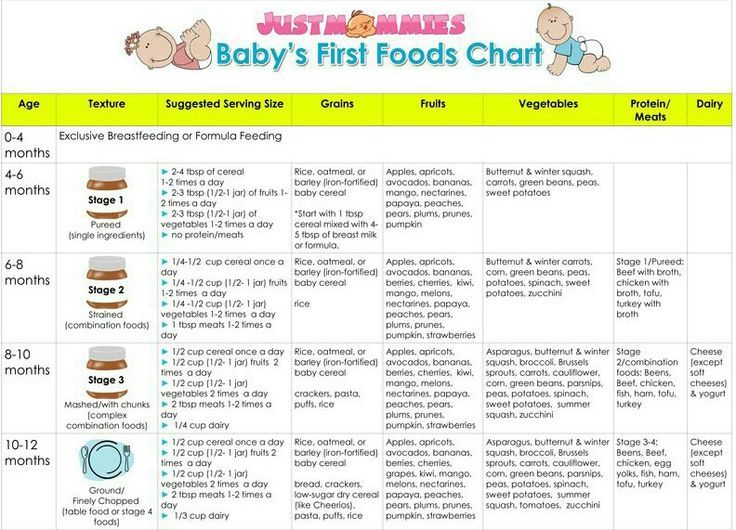 ”
”
How to tell your baby is ready for table food
Your child’s readiness to start table food will likely be more discernible than any other baby food stage. As long as they’re continuing to hone their oral skills, as well as their ability to pick food up and bring it to their mouth, you can count on them to let you know they’re ready for “big kid” food.
“My daughter looked like she was ready for pasta, eggs and basically anything we were eating shortly after she started solids,” says mom of two Julie Cortez of Brooklyn, New York. “We waited until about 8 months, when we knew she knew how to properly eat, and sure enough, she ate her whole plate on the first go! We completely skipped the Stage 3 jars of food.”
Follow these safe feeding must-knows
Even though your baby’s eating skills will continue to progress as they gain more experience, it’s important baby is always sitting upright, strapped in a high chair and never left unattended while eating. Also, make sure table food is always soft and cut into small pieces to avoid choking hazards. When first starting out with solids, be sure to wait a few days before giving them something new.
When first starting out with solids, be sure to wait a few days before giving them something new.
“This allows for observation for any adverse reaction or intolerance to the new food,” Thompson says.
And finally, be sure to give your baby a wide range of healthy food in order to expose them to a variety of tastes and textures — and don’t be discouraged if they don’t take to a specific food at first.
“If baby refuses a food or makes a strange face when eating, this may simply mean that it is a new food and unfamiliar to them,” Thompson says. “Try again. It may take 10 to 20 exposures of a new food before they accept it.”
Here’s more on every baby food stage:
- Stage 1 baby food.
- Stage 2 baby food.
- Stage 3 baby food.
Guide to Baby Food Stages (Purees and BLW)
Learn everything you need to know about Baby Food Stages in this easy-to-read, comprehensive guide. It explains the different feeding stages, going over what every stage — Stage 1, Stage 2, and Stage 3, Finger Foods, and Baby-Led Weaning — is all about.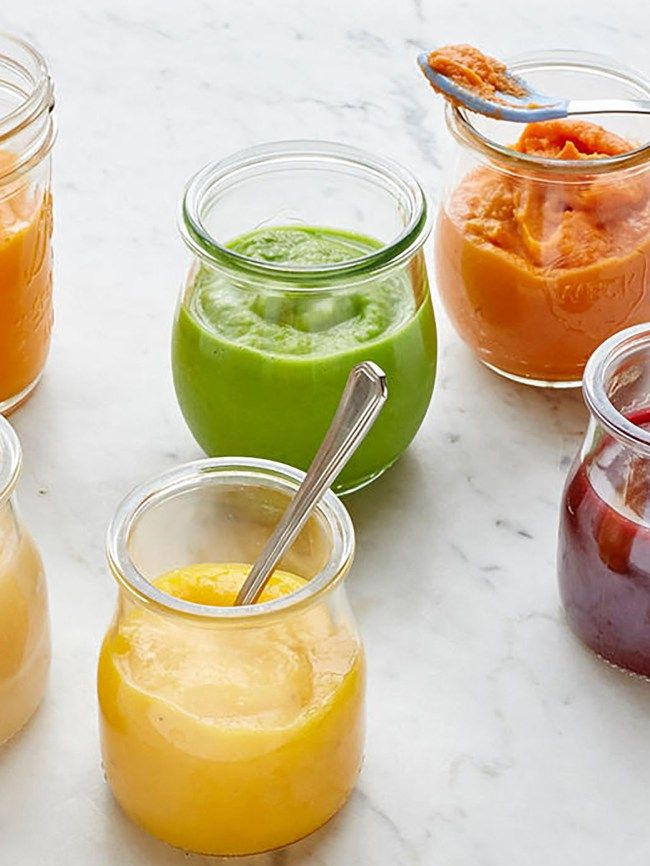
Medically reviewed by Jamie Johnson, Registered Dietitian Nutritionist (RDN)
Baby Food StagesAre you finding the baby food feeding stages confusing?
Well, you are not alone!
Stages 1, 2, 3, table foods, finger foods, baby-led weaning… ahhh… help! What does it all even mean? 🤯
Don’t worry; I’m here for you!
I broke down each stage into an easy-to-digest (pun intended) guide. 👊
What is in this guide:
- Baby Food Ages
- When Can Baby Start Solids?
- Overview: Purees – Stages 1, 2 and 3
- Overview: Baby-Led Weaning or Finger Foods
- Stage 1 Purees
- Stage 2 Purees
- Stage 3 Purees
- Baby-Led Weaning or Finger Foods
Baby Food Stages Video
Watch this video to see how the different baby food stages compare.
Baby Food Ages- Stage 1 Purees: 4-6+ months
- Stage 2 Purees: 6+ months
- Stage 3 Purees: 9+ months
- Finger Foods: 10+ months
- Baby-Led Weaning: 6+ months
When a baby can start on solids is determined by their own rate of development.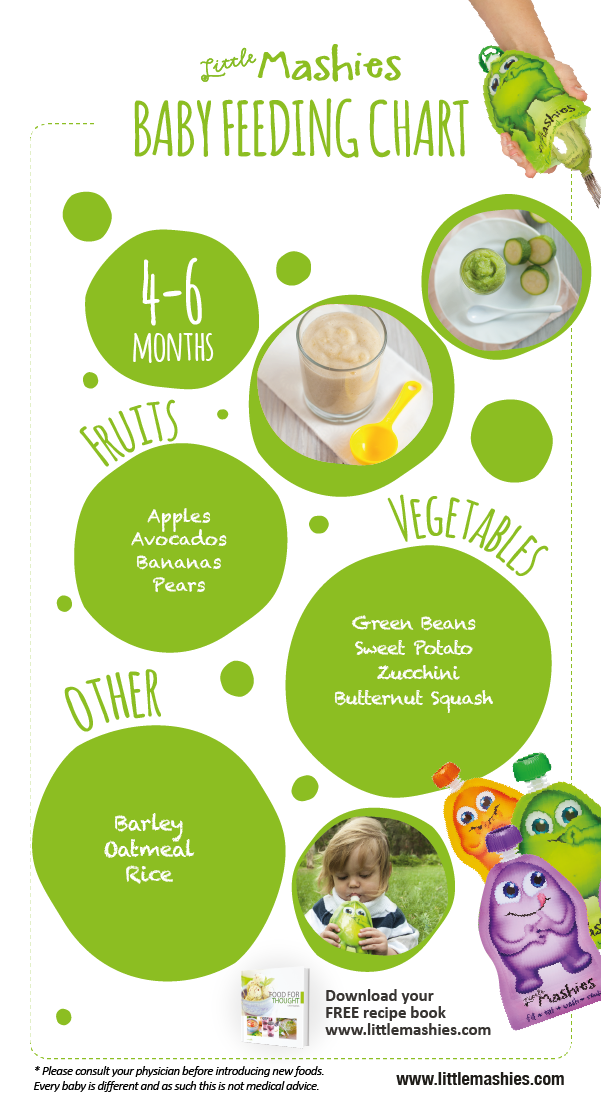 Generally, it occurs between 4-6 months of age for purees and 6+ months for baby-led weaning. Some of the developmental milestones babies need to reach in order to start solids include: if your baby has solid control of their head and neck, if your baby has doubled in weight, and if your baby is reaching for or opening their mouth when you eat (see my guide here). But remember, before you start baby on solids, you should consult with your pediatrician to make sure your child is developmentally ready.
Generally, it occurs between 4-6 months of age for purees and 6+ months for baby-led weaning. Some of the developmental milestones babies need to reach in order to start solids include: if your baby has solid control of their head and neck, if your baby has doubled in weight, and if your baby is reaching for or opening their mouth when you eat (see my guide here). But remember, before you start baby on solids, you should consult with your pediatrician to make sure your child is developmentally ready.
So, to start, Baby Food Purees are grouped into 3 different stages — Stage One, Stage Two, and Stage Three. Without a doubt, they all consist of baby food purees. But they actually range from single-ingredient smooth purees to chunky combination purees filled with soft-cooked foods. Here’s a quick reference:
Stage One- the first stage of feeding
- single-ingredient thin purees
- smooth and easy to swallow
- high chair
- suction bowl
- spoons
- bib with food catcher
- slightly thicker
- combination purees made up of several different ingredients like fruits and vegetables
- may also include yogurt, grains, and proteins
- combination purees with soft-cooked chunks of food
- perfect for babies that need to practice chewing and swallowing foods
First time making homemade baby food? Then, I would suggest that you start by reading my very in-depth Guide on how to Make Homemade Baby Food – which goes over all the important information such as the best cooking tools to have on hand, safe storage, how to know when baby is ready for solids, how to introduce purees, the best first foods for baby, and more! If you are doing Baby-Led Weaning, then be sure to check out my Complete Guide to Baby-Led Weaning – which covers what exactly is baby-led weaning, to every parent’s concern of baby-led weaning and choking, this guide goes over it all. I will also share how to know when baby is ready for BLW, the top 10 best first foods, a helpful sample blw feeding schedule, helpful tools to have on hand, and much much more!
I will also share how to know when baby is ready for BLW, the top 10 best first foods, a helpful sample blw feeding schedule, helpful tools to have on hand, and much much more!
Basically, Baby-Led Weaning and Finger Foods are the same types of food; they’re just served to your baby at different times. Baby-Led Weaning is a newer approach to feeding your baby where you skip the puree stages altogether. Rather, you serve baby chunks of cooked food. Whereas Finger Foods, or sometimes referred to as Table Foods, are typically served to your baby after they master Stage 3 baby food purees.
In short, finger foods are served at 10+ months and baby-led weaning starts at 6+ months.
You can read more here: The Ultimate Guide to Finger Foods for Baby-Led Weaning.
Baby-Led Weaning Products We Love- high chair or clip-on chair
- mat for under high chair
- suction plate
- self-feeding spoons
- long-sleeved bib
Stage 1 baby food is the first type of puree you will be introducing to your baby.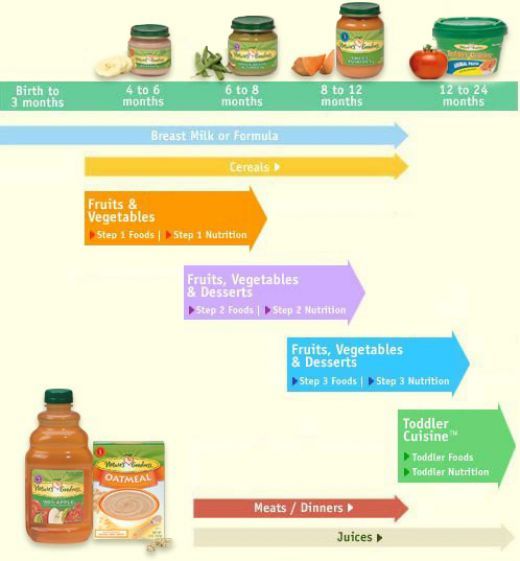 Made with a single ingredient and pureed until smooth, these simple purees are perfect for your budding eater. Besides, they are nutritious and full of flavor!
Made with a single ingredient and pureed until smooth, these simple purees are perfect for your budding eater. Besides, they are nutritious and full of flavor!
- age: 4-6+ months
- single-ingredient recipes
- smooth texture
- can be thinned out (similar to a thick soup but dripping off the spoon)
- first bites can be fruits, veggies, or grain cereal
Here are a few tips:
- first, offer your baby one puree at a time to watch for any allergic reactions
- also, consider offering different colors of food and flavors to start developing their palette
- 15 Stage One Baby Food Purees (4-6 months)
- 4 Homemade Baby Cereal Recipes (4+ months)
- 36 Healthy + Homemade Baby Food Recipes (4+ Months)
Meanwhile, Stage 2 purees will make your baby’s mealtime more exciting with multiple ingredients. This time, you can focus on exposing your baby to various fruits, veggies, grains, and proteins. Plus, you can also add spices and herbs to come up with appetizing and unique flavor combinations.
Plus, you can also add spices and herbs to come up with appetizing and unique flavor combinations.
- age: 6+ months
- combination of multiple-ingredient purees
- smooth texture
- can have a thicker consistency than stage one purees
- great way to expose your baby to a variety of flavors and food colors
- may include plain yogurt, grains, and proteins
- 18 Stage 2 Baby Food Purees (That Baby Will Actually Eat)
- 15 Fast + Easy Baby Food Recipes (made in under 15 minutes!)
- 18 Breakfast Ideas for Baby (6+ months)
In contrast, Stage 3 is full of hearty meals with multiple-ingredient purees plus soft-cooked chunks of food. This stage is all about giving your baby time to learn how to chew and swallow small pieces of soft foods. Then the next step will be finger foods or table foods.
- age: 9+ months
- combination purees and soft-cooked chunks of food
- also a great way to expose your baby to various food flavors and colors
- features wholesome fruits, vegetables, grains, meats, yogurt, even spices
- easy to make — simply pulse your own meal with a blender to turn it into a baby meal
- 18 Stage 3 Baby Food Recipes (Easy, Delicious + Homemade)
As mentioned, Baby-Led Weaning is actually a newer approach to feeding your baby where you skip the puree stages altogether.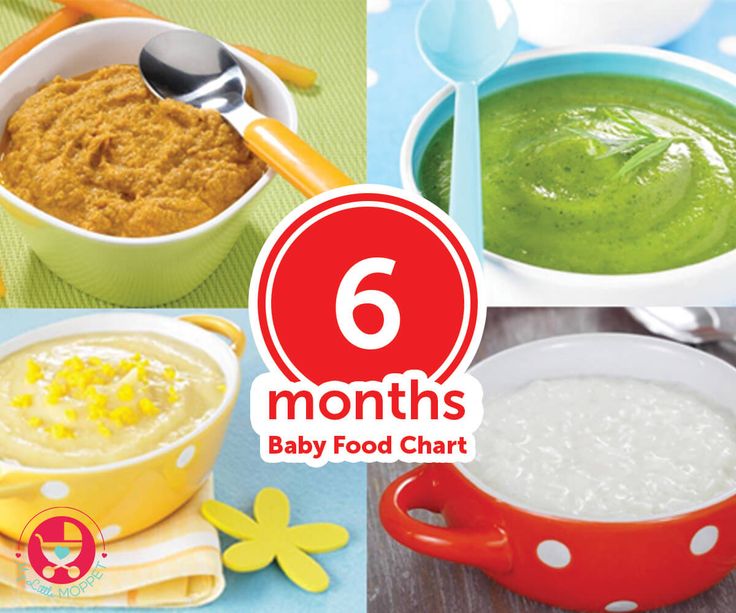 Instead, you serve small chunks or strips of cooked food right from the very start. Ultimately, you would be feeding your baby the exact food you are having at that meal.
Instead, you serve small chunks or strips of cooked food right from the very start. Ultimately, you would be feeding your baby the exact food you are having at that meal.
However, finger foods can be served to your baby after Stage 3.
To sum up, finger foods and the food you serve to baby for Baby-Led Weaning are the same foods. But they are served at different times during your baby’s eating journey. Finger foods are served at 10+ months, while baby-led weaning starts at 6+ months.
If you want to learn more, check out my Ultimate Guide to Finger Foods for Baby-Led Weaning.
- baby-led weaning age: 6+ months
- finger food age: 10+ months
- both include chunks of cooked foods
- can be served in 2-3 inch strips or chopped to pea-sized pieces
Remember, avoid hard foods such as hot dogs, popcorn, dried fruit, nuts, etc., that can be choking hazards.
Baby-Led Weaning (Finger Food) Recipes- 125 Baby Led Weaning Foods (Starter Foods + Recipe Ideas)
- 8 Baby-Led Weaning Meal Ideas for Baby + Toddler
- 6 Baby-Led Weaning Breakfast Ideas
WHO recommendations for the introduction of complementary foods
08.08.2019
Readiness of the child to complementary foods According to the WHO recommendation, existing for 2018, it is optimal to introduce complementary foods to an infant at 6-8 months. Until six months, the baby's gastrointestinal tract is still not sufficiently formed, all the necessary enzymes are not produced for the assimilation of food other than mother's milk or formula. And by 9-10 months, the child can already form stable stereotypes of eating only liquid food, and overcoming them will be painful and difficult for the baby.
Thus, WHO defines the following signs of a child's readiness for the introduction of complementary foods: the maturity of the digestive system; extinction of the solid food ejection reflex; the appearance of the first teeth, making it possible to chew; the readiness of the baby to be stable in an upright position; emotional readiness for new tastes and sensations.
Complementary feeding system WHO has developed recommendations for three complementary feeding options: cereals, vegetables, and meat.
Fruit complementary foods are not recommended for cereals and vegetables. This is due to the fact that up to 8-9 months the gastrointestinal tract of the baby is not ready for the absorption of raw fruits and fruit juices. It is vegetables and cereals that will populate the intestines with the necessary bacteria for the absorption of fruits.
Kefir, according to the WHO, is not considered complementary foods because it is not a solid food. The WHO complementary feeding scheme includes kefir only as an additional food from 8 months. The introduction of cow's milk is recommended by WHO only from 12 months.
Any complementary feeding scheme assumes that portions of complementary foods will systematically increase from half a teaspoon to 100-200 g. The first dishes for complementary foods are prepared exclusively with one-component. Each next component is introduced only after complete addiction to the previous one (6-7 days).
Each next component is introduced only after complete addiction to the previous one (6-7 days).
Product sequence
The following sequence of introduction of complementary foods is proposed.
- Vegetables at 6 months.
- Porridges on the water (oatmeal, buckwheat, corn) at 6.5 - 7 months.
- Fruit puree, yolk at 8 months.
- Milk porridge at 8-9 months.
- Meat puree at 9 months.
- Meat by-products at 9-10 months.
- Kefir, cottage cheese, yogurt at 9-10 months.
- Fish at 10 months.
- Juice at 10-12 months.
- Berry puree at 12 months.
- Meat broths at 12 months.
The introduction of vegetable oil (olive, sunflower) in puree and porridge is allowed from 6 months: a scheme with 1 drop with a gradual increase to a volume of 1 teaspoon. The introduction of butter begins at 7 months: the scheme is from 1 g to 10 g in porridge.
For formula-fed babies, the first feeding schedule is similar, with a few exceptions. For these babies, it is better to introduce complementary foods from 5 months, because the milk mixture does not give the small body all the “building material”. The introduction of complementary foods differs only in terms: vegetable purees and cereals are introduced a month earlier.
First cereals
If the child's weight is significantly less than normal, WHO recommends starting complementary foods with non-dairy cereals. For babies, cereals are prepared only with non-dairy, unsalted, semi-liquid, absolutely homogeneous in consistency. The first cereals are prepared from cereal flour (the sorted and washed cereals are carefully ground and crushed).
The following sequence of introduction of cereals is proposed: buckwheat, rice, corn, oatmeal, semolina. It is recommended to cook semolina porridge only once a week, because it contains practically no nutrients, but it is rich in gluten, which can cause problems in the intestines. Proportion for the preparation of the first porridge: 5 g of cereal flour per 100 ml of water. After slightly cooling the finished porridge, chop again. In the finished porridge, you can add 1-2 drops of vegetable oil or a little expressed breast milk.
Proportion for the preparation of the first porridge: 5 g of cereal flour per 100 ml of water. After slightly cooling the finished porridge, chop again. In the finished porridge, you can add 1-2 drops of vegetable oil or a little expressed breast milk.
From 9 months, the baby's nutrition system involves multicomponent cereals, from products already well known to the child. You can already add vegetables and fruits familiar to the baby to cereals. At 9 months, it is allowed to cook barley and millet porridge for babies. And by 10-11 months, cereals on the water will be a great addition to meat and fish meatballs and steam cutlets.
Vegetable food
The first purees are made from one vegetable.
The sequence of introducing vegetables into complementary foods for babies suggests the following order: zucchini, cauliflower, pumpkin, potatoes, carrots, green peas, beets. These vegetables are introduced within 6-9baby months. After 1 year, you can give your child cucumbers, eggplants, tomatoes, sweet peppers, white cabbage.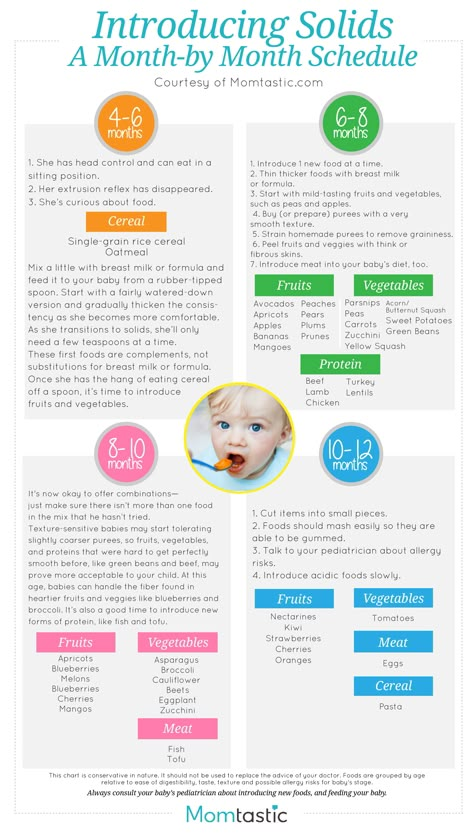 After preparing the puree, make sure that the mass is completely homogeneous, there are no fibers and small particles, the consistency is semi-liquid. Don't salt. Add 1-2 drops of vegetable oil or expressed milk.
After preparing the puree, make sure that the mass is completely homogeneous, there are no fibers and small particles, the consistency is semi-liquid. Don't salt. Add 1-2 drops of vegetable oil or expressed milk.
If the child refuses vegetable complementary foods, cancel this product for 1-2 weeks. Try to temporarily replace it with another and return to it after a while.
Meat supplements
From 9 months old, the first meat purees are recommended for babies. The first courses are recommended to be prepared from lean meats: rabbit; quail; turkey; chicken.
Complementary foods for a 6-month-old baby are recommended to be introduced in the morning. This will allow you to track the child's reaction to an unfamiliar product before a night's sleep: is there a rash, intestinal disorders, anxiety in the baby, profuse regurgitation. It is better to give vegetables or porridge first, and then saturate with breast milk or formula. Gradually, porridge and a vegetable dish will replace one full meal. The dish must be warm and freshly cooked. Gradually, by the age of 1, your baby will develop taste preferences. You will know what dishes he eats with pleasure. In the meantime, try to fully expand the child's diet with products necessary for growth and development.
The dish must be warm and freshly cooked. Gradually, by the age of 1, your baby will develop taste preferences. You will know what dishes he eats with pleasure. In the meantime, try to fully expand the child's diet with products necessary for growth and development.
Be healthy!!!
Breastfeeding first complementary feeding schedule
Complementary feeding during lactation is a small amount of food that is given to the baby in addition to mother's milk. Such food can be meat, cottage cheese, vegetables, fruits, cereals. The question of what kind of first complementary foods to introduce to a child is relevant for inexperienced parents. When planning to supplement breastfeeding, it is important to consider the timeliness factor. If the baby’s nutrition is not expanded at the required time, he will suffer from a lack of weight, a deficiency of nutrients in the body. In this case, favorable conditions are created for weakening the immune system and the development of various diseases. A neonatologist or an observing pediatrician will help to draw up a scheme for the optimal introduction of complementary foods for the baby.
A neonatologist or an observing pediatrician will help to draw up a scheme for the optimal introduction of complementary foods for the baby.
What is complementary foods and from what month is it usually introduced? The purpose of expanding the children's diet is to saturate the baby, create conditions for its full development.
Even at the consultation stage, neonatologists warn mothers about the age at which the first complementary foods are - on average, from six months. In many ways, this indicator depends on whether the baby was born full-term, whether he has chronic diseases, how he tolerates the use of mother's milk. Only if there are special medical indications, the first complementary foods are prescribed at 4.5-5 months.
Up to six months, the body of a newborn receives nutrients (vitamins, enzymes, minerals) during lactation. But as the baby grows and develops, its needs for useful components also increase. Supplement to mother's milk helps to meet the need of the child's body for magnesium, calcium, zinc, iron.
Experts emphasize not that the use of juice as a first complementary food is not entirely correct: it refers to corrective supplements, and not to nutrition. In addition, an attempt to supplement the children's menu with such a product leads to the development of diarrhea in the child, and a high concentration of sugar reduces appetite, and children consume less milk. Another reason why experts do not recommend starting complementary foods with juice is the high risk of developing diathesis. This is also due to the high content of glucose in the product.
There are 2 programs for the introduction of the first complementary foods. The first scheme involves supplementing the children's diet with fruits, the second - with cereals and vegetables. Mom can be guided by the opinion of the observing pediatrician. The best solution is to start with white and green vegetables. But exotic options and potatoes must be excluded. In the first case, the restriction is explained by the unpredictable reaction of the child's body, in the second - by a high concentration of carbohydrates and difficult digestion of the vegetable.
How to tell if a baby is ready to start weaning and how to start it
Before creating a breastfeeding complementary feeding schedule, parents need to make sure their baby is ready to expand the diet with new foods.
Signs by which this can be determined:
- The child's appetite has increased, the frequency of feeding has noticeably increased.
- The baby is not saturated with mother's milk, although it empties the breast.
- Newborn shows interest in other foods. Trying to let your baby try a new product does not cause the child to turn away from the spoon or push it out with their tongue.
- The child has learned to take food with his hands.
- The kid demonstrates perseverance and readiness to use additional products.
- The child has stopped gaining weight because mother's milk for his body is not enough.
The presence of the listed signs serves as the basis for planning the first feeding. But, when planning to supplement the children's diet with new products, you need to consider: this is unacceptable to carry out 3 days before vaccination and for 6 days after it. The contraindication is due to the fact that an allergic reaction to the vaccination performed can be mistaken for signs of intolerance to complementary foods.
But, when planning to supplement the children's diet with new products, you need to consider: this is unacceptable to carry out 3 days before vaccination and for 6 days after it. The contraindication is due to the fact that an allergic reaction to the vaccination performed can be mistaken for signs of intolerance to complementary foods.
Also, experts do not recommend introducing a new product into the diet if the child is undergoing conditionally stressful events. These include a trip, a move, a change in climatic conditions, a period of teething, high air temperature.
First complementary food
First complementary food - fruits, or vegetables and cereals. If parents have doubts about which option is best for a child, you can consult with the observing pediatrician.
Feeding table for breastfeeding:
1. At six months - vegetables, once a day (for example, at lunch). In 1 tsp. zucchini puree add a few drops of vegetable oil, breast milk.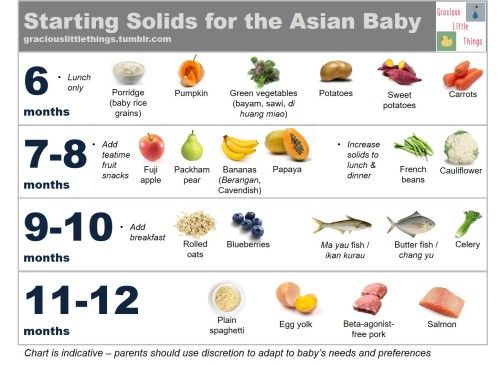 A week - up to 60-70 g of complementary foods. After 7 days, it is permissible to introduce cauliflower into the child's diet. From 3 weeks you can supplement baby food with pumpkin.
A week - up to 60-70 g of complementary foods. After 7 days, it is permissible to introduce cauliflower into the child's diet. From 3 weeks you can supplement baby food with pumpkin.
2. At 7 months - porridge, 1 time per day. Initially, the dish must be made liquid, then the density can be increased.
3. At 8 months - fruits (for breakfast), cottage cheese (for dinner) 1 time per day.
4. At 9 months - meat (addition to vegetables), 1 time per day. The broth cannot be introduced into the diet yet. Give meat in this order: rabbit, turkey, beef. Then you can introduce egg yolk into the diet.
5. At 10 months - fish.
6. After 12 months - milk, juice (natural, not factory-made).
The indicated schedule can be adjusted according to the child's appetite and other factors. Children are allowed to consume water, compote and tea, starting from the first days of the introduction of complementary foods.
It is better to give kefir to newborns at night, but you need to start with a few drops. Gradually, the volume of the fermented milk product should be brought up to 100 g.
Gradually, the volume of the fermented milk product should be brought up to 100 g.
Rules for the first feeding and advice to mothers
To ensure the full growth and development of the child, it is important to follow the rules for the first feeding:
- Give new foods only from a spoon. So the child will quickly get used to the chewing process, and parents will be able to avoid the problems that arise due to the baby getting used to bottle feeding.
- Use dairy-free cereals. They need to be boiled in water, diluted with mother's milk, which should be expressed immediately before feeding.
- Do not introduce potatoes into the diet of a child under 1.5 years of age. The use of this vegetable should be started only with its preliminary dissolution with mother's milk. This increases the likelihood of assimilation of potatoes, the absence of intestinal colic.
- Start a food diary. Organized records will allow you to track the baby's reaction to a change in nutrition and each new product separately.
 In the diary, indicate the type, volume of food, the culinary type of its processing. Pediatricians recommend keeping a systematic record from the start of the introduction of complementary foods until the child reaches the age of 1.5 years.
In the diary, indicate the type, volume of food, the culinary type of its processing. Pediatricians recommend keeping a systematic record from the start of the introduction of complementary foods until the child reaches the age of 1.5 years. - If children are prone to constipation, the introduction of a large amount of bananas and pears into the diet is contraindicated. With such a feature of the state of the body, it is advisable to use apples, peaches, apricots. They weaken the activity of the intestines, help prevent the development of problems with bowel movements.
- Introduce new products into the diet at intervals of 7 days. This will allow you to track the reaction of the newborn's body to each product separately.
There are no specific restrictions on the use of complementary foods. In one case, the child can eat 50 g, in the other - 150 g. Parents need to focus on the baby's appetite, and not limit the one-time amount of food, since the main goal of expanding the menu is to saturate the growing body.

